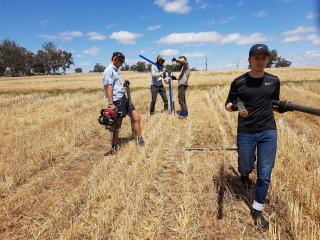Western Australia
February 22, 2021

Members of DPIRD plant pathology research team Cameron Lewis (left), Steve Rossi, Campbell Eaton and Jono Swift take soil samples from the Darkan trial site for a project to better understand the impact of soil amelioration on soil biology to help boost grain growers’ yields and profitability.
A series of projects researching how soil amelioration affects soil biology is unearthing new information, as it digs deeper into the impact of mechanical soil amelioration on soilborne diseases and nematode pests in cereal crops.
Collaborative research by the Department of Primary Industries and Regional Development will be profiled at the Grains Research and Development Corporation’s (GRDC) Grains Research Updates next week.
While the benefits of mechanical soil amelioration are well known in WA, comparatively little is known about its impact on soilborne pathogens and nematode pests.
Department nematologist Sarah Collins will present findings from field trials of the first two ‘transition seasons’ following renovation, when the physical and chemical composition of the changed soil environment is settling.
Dr Collins said the research found the influence of soil amelioration on soilborne pests and diseases varied depending on the site, depth and mechanical renovation method employed.
“Initial results suggest the soil biological community was reduced in the topsoil by soil inversion but was stimulated by all amelioration treatments at other depths, particularly between 10 and 20 centimetres,” she said.
“Soil inversion stimulated soil biological activity and increased Rhizoctonia solani (R. solani) pathogen levels and nematode pests at 10 to 40 centimetres depth, where they are not usually found in WA soils that have not been ameliorated.”
The research draws information from field trials in 2019 and 2020 at a yellow sand site near Yerecoin and a duplex sandy gravel site at Darkan, which compared soil inversion, soil mixing and deep ripping with un-ameliorated controls.
The sites selected had a range of challenging physical, chemical and biological constraints.
Dr Collins said it was interesting that R. solani, a fungal pathogen, responded differently to soil amelioration in comparison to plant parasitic nematodes.
“The soilborne nematode species P. neglectus and P. quasitereoides and the cereal cyst nematode Heterodera avenae also responded differently to each other,” she said.
“It appears that the fungi and nematodes have different responses to the changed soil profiles following mechanical amelioration.
“Further investigation is required to better understand the implications of soil amelioration on the presence and multiplication of these biological soil constraints over time.”
The research also found that crops sown on plots that had undergone soil inversion consistently out-yielded the control, deep ripping and soil mixing treatments.
The soil inversion treatment produced a 17 per cent or more yield increase, equating to 0.6 to 0.7 tonnes per hectare, compared with the control treatment at Yerecoin and Darkan in barley in 2019 and wheat in 2020.
Research scientist Stephen Davies said the yield benefits arising from inversion could be due to a combination of factors.
“The trials suggest that more complete burial of topsoil with associated organic matter, nutrients, weed seeds and soil biology into 10 to 30 centimetres of the crop root zone produced an advantage at these highly constrained, challenging sites,” Dr Davies said.
“Weed control is clearly a very important component – especially at Yerecoin – but associated nutrient access, reduction in water repellence – particularly at Darkan – soil pH changes and the impact on the pests/pathogens could all be playing a role.”
The research has been undertaken with co-investment from the GRDC and the department’s Science Partnership project collaborators.
This Science Partnership project involves DPIRD and The University of Western Australia, Agriculture Victoria and the Department of Primary Industries and Regions research division South Australian Research and Development Institute (SARDI).
More details about the trials and the complementary research projects will be discussed at GRDC Grains Research Updates 2021 in Perth and at Regional Updates at Albany on 3 March, Merredin on 12 March and Geraldton on 17 March 2021.
For more information or to register visit the GRDC Upcoming Updates and Events webpage, which will also have advice should COVID emergency measures be in place.